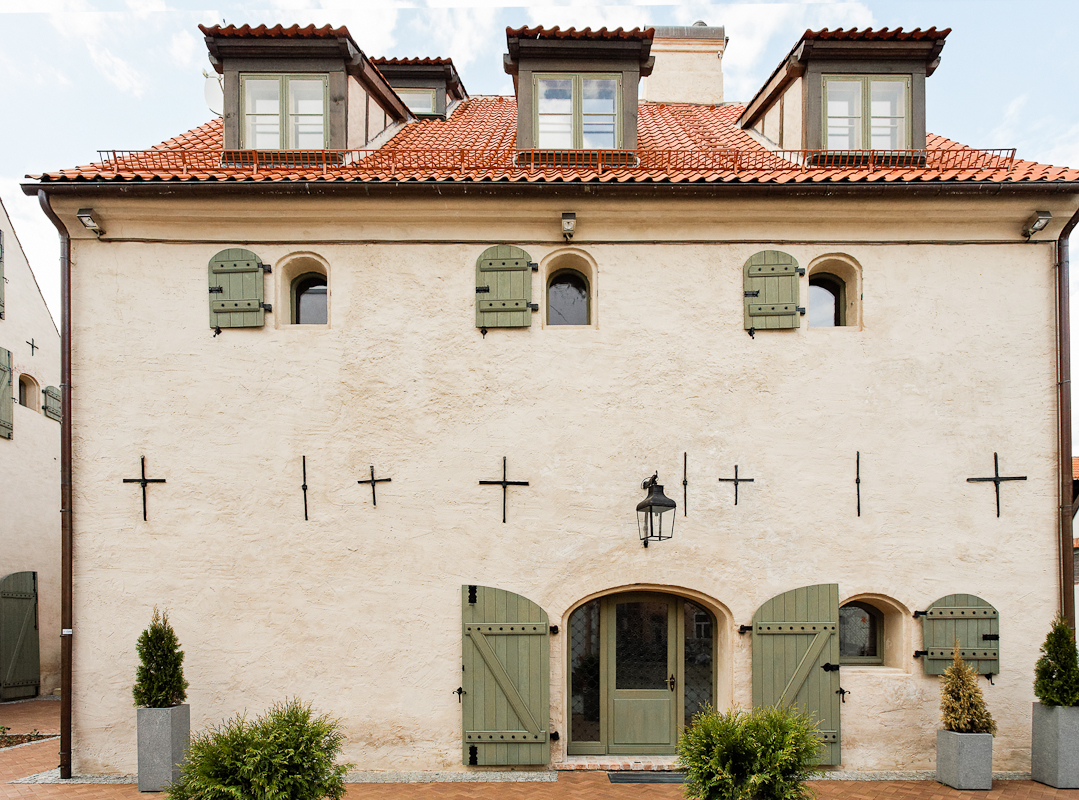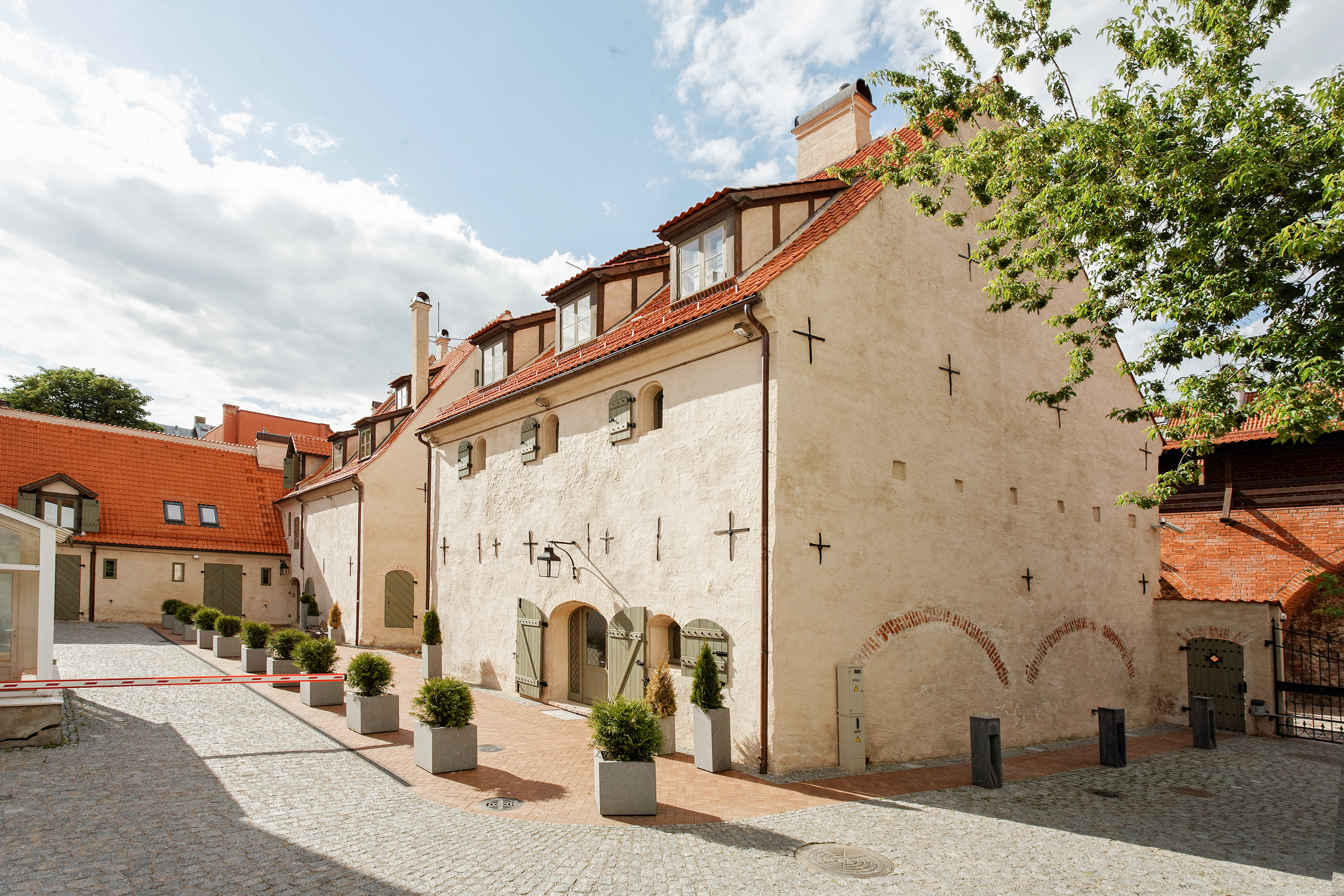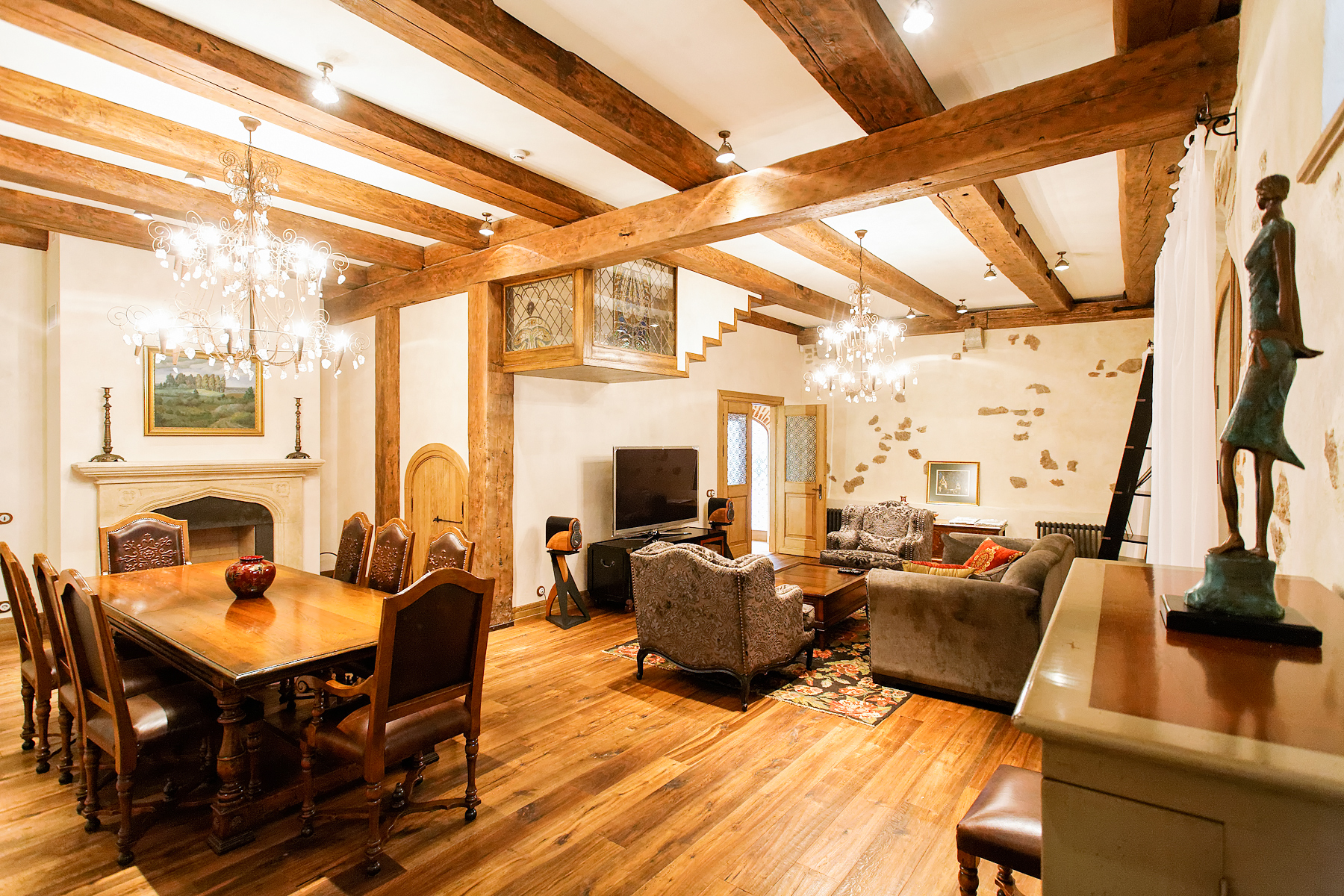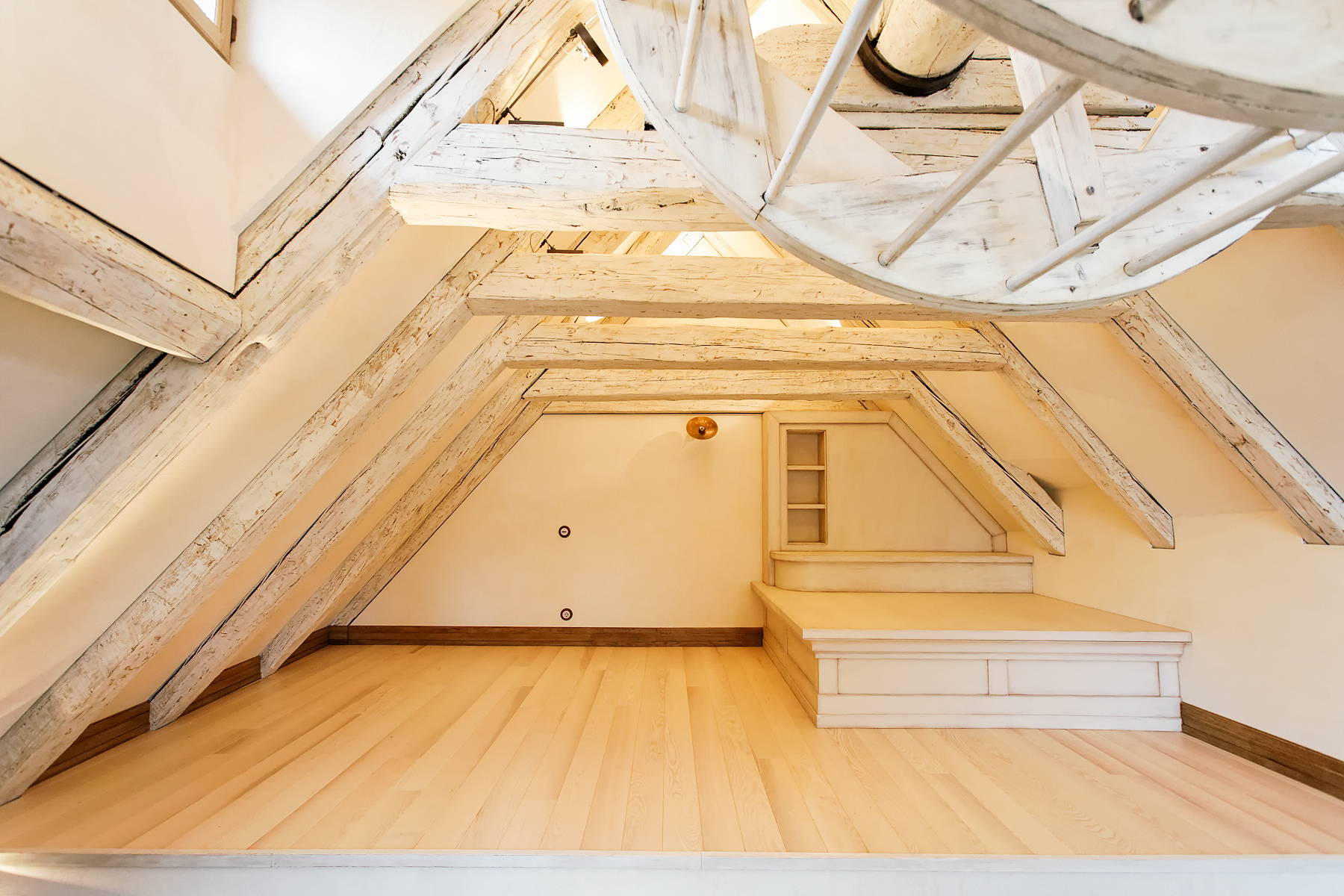A CONVERTED 16TH-CENTURY BARN IN RIGA’S OLD TOWN
$3.62 MILLION (3.2 MILLION EUROS)
This home in the Old Town of Riga, Latvia, is a former barn dating to the 16th century that was converted into a single-family home in late 2012. Over the centuries, the three-story medieval barn, with a partial fourth story, was also used as a warehouse; it has a large wooden wheel in the attic used to convey items up and down.
The nearly 3,000-square-foot home, which has four bedrooms and three and a half bathrooms, is part of a complex that includes two other buildings, also renovated in recent years but separately owned.
The home, of red brick with a plastered facade, sits on a lot of about 0.10 acre, currently used as a small terrace with off-street parking, which is rare in Riga’s Old Town. Arturs Lapins was the architect who handled restoration of the buildings’ historic elements.
The main entrance to the home is through a gate off cobblestone Troksnu Street, said Ilze Mazurenko, a Responsible Broker and the Member of the Board of Baltic Sotheby’s International Realty, who has the listing. The house was renovated “according to all the rules and regulations of the government,” Ms. Mazurenko said, including restoring metal crosses and wooden arched shutters found on the facade.
Potted plants surround a terrace leading to the traditional green arched front door, which opens to a foyer with a staircase and elevator. Beyond is a spacious open living and dining room with a working wood-burning fireplace with a marble surround. Exposed oak beams adorn the ceilings. Beyond the living room is a kitchen, with wood painted cabinets, granite countertops, breakfast bar and high-end appliances.
Most floors are oak, while some rooms, including the kitchen, have brick floors. Furniture is included in the home’s asking price.
The second floor has a master-bedroom suite, with a living area, a chess room and a walk-in closet. Its bathroom has a bathtub, glass shower with rain shower head, bidet and Villeroy & Boch fixtures. There are also laundry facilities on the second floor.
The two bedrooms on the third floor have slanted ceilings with exposed beams and dormer windows. Both have en-suite bathrooms with showers. A partial fourth floor is a loft with a built-in platform bed and a skylight. The antique wooden wheel is a feature of this room.
The home has a central location near the Swedish Gate, built in 1698 during Swedish occupation and the only such structure left in Riga. Jacob’s Barracks is a collection of 18th-century red-roofed buildings along Torna Street, just steps from the house, that has been restored several times and is home to a number of bars, restaurants and shops. Tourist attractions like Dome Square and St. Peter’s Church are a short stroll away; other sites can be reached by public transportation, which includes bus, rail and trolley. Riga International Airport is about 15 minutes by car.
More information about the property is here.
MARKET OVERVIEW
Though home prices fell in Latvia in the second part of 2007 by as much as 65 percent, and the economy was close to collapse, things have turned around since 2010, largely thanks to international aid and a government residency permit program, agents said.
“More than any other sector, housing went through a shock in 2008 and 2009 that gave everyone a good lesson,” said Aldis Riekstins, the head of customer services with Latio, a real estate company with offices in Latvia.
A 2010 change to immigration policy enabled any non-European Union buyer of a home costing at least 143,000 euros, about $162,000, in a large city, or 72,000 euros, about $81,000, elsewhere, to apply for a five-year residency permit in Latvia. But in the fall of 2014, the minimum price for a property in the residency permit program was raised to 250,000 euros, about $283,000, in any part of the country.
“When the residency permit program threshold was increased in September 2014, the number of transactions declined by more than 50 percent in 2015,” Ms. Mazurenko said. Prices in 2015 fell by about 10 percent, she said.
Currently, average home prices are about 59 percent lower than they were at their height in July 2007, when an unrenovated standard-type apartment cost 1,620 euros per square meter, or $170 a square foot, said Aigars Smits, chairman of the board of directors of Arco Real Estate, with offices in Latvia.
A single-family home in the Old Town of Riga is typically very hard to come by, with areas like Mezaparks or Baltezers being more likely places to find single-family homes, Ms. Mazurenko said. Foreign home buyers traditionally have been attracted to the Art Nouveau embassy district in Riga, called the “silent center” for its quiet, but generally they are seeking apartments, she said.
Currently, the most expensive average prices in Riga are in the “silent center,” where homes start at around 1,300 to 1,900 euros per square meter, or about $135 to $200 a square foot, and range up to 4,000 euros per square meter, or about $420 a square foot, for apartments in renovated prewar buildings with impressive architecture, Mr. Smits said.
Other areas that have been popular with foreign buyers are Kipsala (an island across the Daugava River), as well as the resort of Jurmala, about a 30-minute drive outside Riga. Prices in Jurmala, the most popular resort city in the Baltic States, Ms. Mazurenko said, tend to start at 800,000 euros, or about $900,000, and range up to 15 million euros, or about $17 million.
WHO BUYS IN LATVIA
According to data collected by the Office of Citizenship and Migration Affairs, properties in Jurmala, a seaside area that was once part of Riga, were most in demand in 2015, with Russian citizens buying the bulk of them, Mr. Smits said. Those buyers were followed by Ukrainians, Chinese, Kazakhs and Uzbeks.
Ms. Mazurenko said that while there are a small number of buyers in Latvia from Sweden, the United States, Britain and Norway, the majority of buyers for the luxury market, which is predominantly in Jurmala, are Russians.
BUYING BASICS
Foreigners cannot buy agricultural land or land near national borders, but there are otherwise few restrictions in Latvia, Mr. Smits said. In Jurmala, Mr. Riekstins said, foreign home buyers cannot buy land in the dune area along the coast.
Notaries typically handle sales transactions, and generally charge 200 to 300 euros, or about $225 to $340, brokers said. The largest expense is the 2 percent stamp duty, and if a mortgage is to be registered, that costs an additional 0.1 percent of the loan, Mr. Riekstins said.
The seller typically pays the real estate agent commission, which ranges from 2.5 percent to 5 percent. Ten- to 20-year mortgages are available for foreign home purchasers and typically require about 50 percent to 70 percent down, with interest rates of 3 percent to 5 percent, brokers said. Most foreigners typically pay in cash, Mr. Riekstins said.
WEBSITES
Latvian tourism: www.latvia.travel
Latvian Institute: latvia.eu
Municipal portal of Riga: riga.lv
LANGUAGES AND CURRENCY
Latvian; euro (1 euro = $1.13)
TAXES AND FEES
As a historically significant property, this home is not subject to property taxes.
CONTACT
Ilze Mazurenko, Baltic Sotheby’s International Realty, (00-371) 29-129-810; balticsothebysrealty.com.
In cooperation with The New York Times.
By Alison Gregor.




